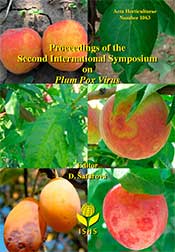Ver ítem
- xmlui.general.dspace_homeCentros Regionales y EEAsCentro Regional Mendoza - San JuanEEA JunínArtículos científicosxmlui.ArtifactBrowser.ItemViewer.trail
- Inicio
- Centros Regionales y EEAs
- Centro Regional Mendoza - San Juan
- EEA Junín
- Artículos científicos
- Ver ítem
Monitoring of Plum Pox Virus concentration at different plant heights throughout the year in prunes (Prunus domestica) in Argentina
Resumen
Sharka, caused by Plum pox virus (PPV), is the most important viral disease of stone fruits worldwide. PPV was detected for first time in Argentina in 2004 and since then many efforts have been made to eradicate it. To optimize sampling and virus detection by DAS-ELISA, 8 PPV-positive prune trees (P. domestica, cv. 'D´agen') were selected and sampled monthly from September 2008 to August 2010. The plant tissue collected was the one available at the
[ver mas...]
Sharka, caused by Plum pox virus (PPV), is the most important viral disease of stone fruits worldwide. PPV was detected for first time in Argentina in 2004 and since then many efforts have been made to eradicate it. To optimize sampling and virus detection by DAS-ELISA, 8 PPV-positive prune trees (P. domestica, cv. 'D´agen') were selected and sampled monthly from September 2008 to August 2010. The plant tissue collected was the one available at the sampling time (leaves, flowers or buds). The samples were taken from each of the four tree scaffolds at three different heights (basal, medium and apical). Variability of absorbance levels in each month was analyzed with Principal Components Analysis and sampling schemes were compared with non parametric variance analysis. This is the first study made in Argentina to tracking PPV relative virus concentration throughout the year. As described previously by many authors in the north hemisphere the highest levels of virus concentration, in both studied years, were found in spring (October and November) using flowers and young leaves. The scaffold basal height showed the highest PPV concentration in these two months. High variation of relative virus concentration levels were found among months, within and between years. Regarding different parts of the plant, relative virus concentration decreased from the base to the apical part of the scaffold, indicating that sampling should be performed at a basal height. This study will contribute to the optimization of DAS-ELISA PPV detection in Argentina.
[Cerrar]

Autor
Marini, Diana Beatriz;
Farrando, Roberto Jes;
Porcel, Laura Beatriz;
Ojeda, Eva Maria;
Picca, Cecilia Nelida;
Fuentes, C.;
Dal Zotto, Angelica;
Teich, Ingrid;
Descripción
II International Symposium on Plum Pox Virus
Fuente
Acta horticulturae 1063 : 177-183. (January 2015)
Fecha
2015-01
Editorial
International Society for Horticultural Science
ISSN
0567-7572
2406-6168 (Online)
2406-6168 (Online)
Formato
pdf
Tipo de documento
artículo
Palabras Claves
Derechos de acceso
Restringido
 Excepto donde se diga explicitamente, este item se publica bajo la siguiente descripción: Creative Commons Attribution-NonCommercial-ShareAlike 2.5 Unported (CC BY-NC-SA 2.5)
Excepto donde se diga explicitamente, este item se publica bajo la siguiente descripción: Creative Commons Attribution-NonCommercial-ShareAlike 2.5 Unported (CC BY-NC-SA 2.5)
Metadatos
Mostrar el registro completo del ítemÍtems relacionados
Mostrando ítems relacionados por Título, autor o materia.
-
Relative incidence of cucurbit viruses and relationship with bio-meteorological variables
Pozzi, Elizabeth Alicia; Bruno, Cecilia Inés; Luciani, Cecilia; Celli, Marcos Giovani; Conci, Vilma Cecilia; Perotto, Maria Cecilia (Springer, 2020-02)Environmental heterogeneity can shape the plant-virus relationship, furthering the appearance of new diseases in crops, or altering disease incidence and severity. In this work, we studied the virus association with ... -
Virosis en zapallito de tronco
Perotto, Maria Cecilia (EEA San Pedro, INTA, 2022)Las principales virosis que afectan al zapallito redondo son las producidas por virus del género Potyvirus. Hay 4 especies de este grupo presentes en Argentina, estos son: Watermelon mosaic virus (WMV), Zucchini yellow ... -
Enfermedades del Poroto
Ploper, Leonardo Daniel; González, Victoria del V.; Rodriguez Pardina, Patricia; Díaz, Cecilia G.; Vizgarra, Oscar Nicéforo (Asociación Argentina de Fitopatólogos, 2024)El género Phaseolus (familia Fabaceae) está compuesto por más de 70 especies botánicas originarias de Mesoamérica y América del Sur. Incluye varias especies de interés hortícola, entre las que se pueden mencionar P. vulgaris ...

